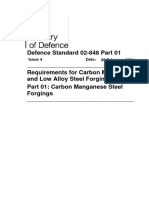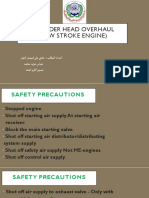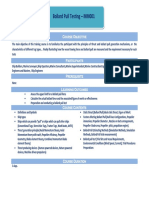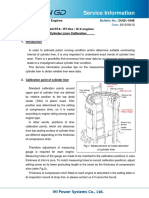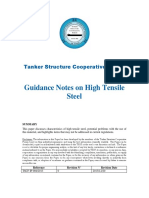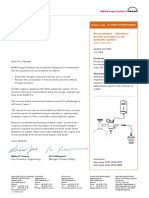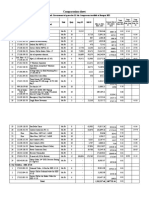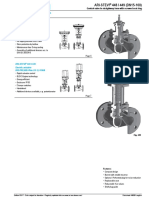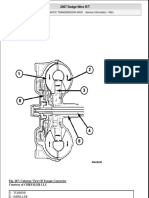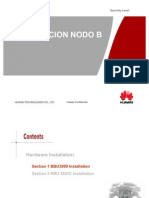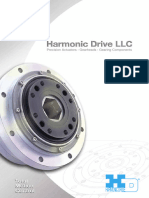48 60
48 60
Uploaded by
j1931ppCopyright:
Available Formats
48 60
48 60
Uploaded by
j1931ppOriginal Description:
Original Title
Copyright
Available Formats
Share this document
Did you find this document useful?
Is this content inappropriate?
Copyright:
Available Formats
48 60
48 60
Uploaded by
j1931ppCopyright:
Available Formats
48/60
Four-stroke diesel engine
MAN Diesel & Turbo
The responsible way in leading technology
MAN Diesel & Turbo is the world’s leading designer and manufacturer of low and
medium speed engines. Our involvement with electrical power generators goes
back to 1904 when we supplied the first ever diesel generator sets to the Kiev Tram
System.
Since those early days, MAN Diesel & Turbo has never lost its technological pre-
eminence in the large engine field. Likewise, our engines have never relinquished
their status as the most efficient combustion engines available.
More than ever before, MAN Diesel & Turbo’s development focus is on the environ
mental performance of our engines. Using our unrivalled grasp of large engine
technology, we aim to make our engines progressively cleaner, more powerful and
more efficient.
With our firm commitment to reducing emissions while increasing fuel efficiency
and power density, and with our active partnership with environmental institutions
and development banks, we intend to be part of the global emissions solution.
48/60 – Four-stroke diesel engine 3
Our Best-Selling Engine A Top Performer
48/60
Both economical and environmentally friendly, the 48/60 is a prime mover in the Stepped piston Sophisticated fuel injection
The forged dimensionally stable steel crown (with High-pressure injection with improved atomisation
truest sense. With a power output range of 9,450 to 18,900 kW, this reliable, high-
shaker cooling) is made from high-grade materials, ensures good combustion with any fuel quality. The
output engine is the four-stroke heart of medium and large diesel power plants the while the skirt is constructed from spheroidal graphite injection system has been designed for lower fuel
cast iron (skirt also available in steel upon request), to consumption and lower emissions.
world over. provide superior durability.
Connecting rod and bearing
Reliable power output Rugged engine block Both the stepped piston and fire ring prevent com- The marine head design, with a joint in the upper
The 48/60 engine can be run on heavy oil with a The engine is housed in a rigid monobloc frame, bustion residue accumulating on the piston crown shaft, allows piston overhaul without removal of the
viscosity up to 700 mm2 /s (cSt) at 50°C. It is designed further strengthened by continuous tie rods. These and cylinder liner. In combination with chromium connecting rod bearing. A low piston height also
for fuel qualities up to the levels specified in CIMAC run from the underslung main bearing to the top edge ceramic coating of the first piston ring and chromium makes overhaul easier. Optimised bearing shells in
2003 H/K700/DIN ISO 8217. In fact, the e ngine is of the engine frame, and from the cylinder head coating of the second and third piston rings, this the connecting rod increase reliability.
capable of continuous operation on heavy oil in an through the intermediate plate. minimises wear of the cylinder liner and reduces
output range of 20 per cent to 100 per cent. For brief lubricating oil consumption. Improved design
periods, it can even operate below 20 per cent. Cylinder liner with fire ring To make the 48/60 even better, the design has been
The thick-walled design provides high resistance Cylinder head and durable valves enhanced. Improvements include better combustion
For engines driving a generator, in accordance with to deformation, preventing cavitation. This leads to Designed for safe, high ignition pressures, the cylin- chamber geometry, a higher density ratio, and more
DIN ISO 8528-1, a 10 per cent overload is allowed for better piston performance and a longer service life. der head is equipped with effective bore cooling. All accurate injection and valve timing. All of these fea-
a brief period for governing purpose (e. g. suddenly Cooling at the top of the liner ensures uniform tem- valves are armoured to reduce wear, and the exhaust tures reduce fuel consumption and improve ignition,
applied load) to prevent frequency drop. perature distribution over the entire surface. valve seats are water-cooled. The exhaust valves even with poor fuel qualities.
have an exhaust-driven rotor, while the inlet valves
are rotated using rotocaps, keeping the valve seat
clean.
4 48/60 – Four-stroke diesel engine 48/60 – Four-stroke diesel engine 5
48/60 Technical Data
Overview
Top turbochargers SaCoS for enhanced safety Engine cycle: four-stroke General definition of diesel engine ratings according
The constant pressure turbocharging system uses On request, all MAN Diesel & Turbo medium-speed Turbocharging system: constant-pressure to ISO 30461/1-2002
state-of-the-art MAN Diesel & Turbo TCA series turbo- engines, including the L48/60, can be equipped with
chargers, with long-bearing overhaul intervals. Their the SaCoS safety and control system. This system is Number of cylinders Ambient conditions according to ISO 3046-1:2002
high efficiency at full and part loads ensures thorough tested at the factory together with the engine, mak- In-line engine: 9 The stated consumption figures refer to the following
combustion with low thermal stress and no residue. ing fine tuning and functional testing easier and V-engine: 12, 14, 18 reference conditions according to ISO 3046-1:
smoother when the power unit is commissioned. Bore: 480 mm
48/60 V-engines are charged by a single TCA turbo- Stroke: 600 mm n Ambient air pressure: 1,000 mbar
charger, with the advantage that the cylinders share Low exhaust emissions Swept volume per cyl.: 108.6 dm3 n Ambient air temperature: 25°C (77°F)
a single exhaust line. A new turbocharger module As with all MAN Diesel & Turbo engines, 48/60 en- n Charge air temperature: According to engine type,
with integrated intercoolers significantly reduces the gines comply with World Bank guidelines for exhaust Cylinder output (MCR) corresponding to 25°C cooling water temperature
engine centres between two adjacent V-engines. emissions. Even lower NOX emissions can be at 514 rpm: 1,050 kW before charge air cooler.
achieved to fulfil worldwide emission standards for at 500 rpm: 1,050 kW
Service-friendly design specific plants. The SFOC figures for engines in diesel operation are based on a
lower calorific value of the fuel of 42,700 kJ/kg.
A number of features make servicing the 48/60 easy: For example, engines can be equipped with MAN’s Cooling
n Hydraulic tools for tightening and loosening cylin- advanced selective catalytic reduction (SCR) tech- Cylinder cooling: cooling water Figures are given with a tolerance of 5 per cent, except for the lubri-
cating oil consumption, which is given with a tolerance of 20 per cent.
der head nuts, and for the crankshaft and big-end nology. Charge-air cooler (two-stage): fresh water
bearings; The more thorough the combustion, the lower the Fuel injector cooling: fresh water
n Clamps with quick-release fasteners and/or clamp particle emissions. MAN Diesel & Turbo’s highly effi-
and plug connectors; cient engines produce particle emission rates well Starting method
n Generously sized access covers; below the World Bank guidelines, provided that fuel compressed air
n A practically maintenance-free sleeve spring vibra- with low ash content is used.
tion damper. Emissions
The engines comply with the World Bank
guidelines for thermal power plants.
6 48/60 – Four-stroke diesel engine 48/60 – Four-stroke diesel engine 7
Dimensiones y pesos
V48/60 motor diesel de cuatro tiempos
W
A B
C
V48/60 motor diesel de cuatro tiempos L48/60 motor diesel de cuatro tiempos
L48/60 motor diesel de cuatro tiempos
9
Potencia de salida (máximo rendimiento continuo)
Motor (kW) Grupo electrógeno (kW)
9L48/60 9 cyl. 9,450 9,195 *
12V48/60 12 cyl. 12,600 12,310
14V48/60 14 cyl. 14,700 14,362
18V48/60 18 cyl. 18,900 18,465
50/60 Hz
# $
Velocidad del motor 500/514 rpm
%
Velocidad media del pistón 10.0/10.3 m/s
Presión media efectiva 23.2/22.6 bar
Eficiencia nominal del generador L-type: 97.3%, V-type: 97.7%
48/60 motor
Potencia calorífica del grupo electrógeno al 100% de la carga Consumo específico de aceite lubricante
Tipo de motor Nº de cilindros A (mm) B (mm) C (mm) W (mm) H (mm) Wt. (t)
kJ/kWh g/kWh
L48/60 (WB 1998) 7,812 L+V48/60 0.5 9L48/60 9 10,545 4,805 15,350 2,970 5,780 223
V48/60 (WB 1998) 7,605 12V48/60 12 9,835 4,950 14,785 4,700 6,250 273
L48/60 (WB 2007/2008) 7,899 14V48/60 14 10,835 5,150 15,985 4,700 6,250 314
V48/60 (WB 2007/2008) 7,779 18V48/60 18 13,148 5,410 18,558 4,700 6,530 375
Carga de referencia específica del tipo de motor Temperatura del aire antes del cilindro 37 °C Todos los pesos y dimensiones se aplican sólo a motores secos sin volante de inercia. Más información disponible a petición.
8 48/60 – Four-stroke diesel engine 48/60 – Four-stroke diesel engine 9
You might also like
- Panda 4x4 Service Repair ManualDocument111 pagesPanda 4x4 Service Repair ManualAlejandro Dos SantosNo ratings yet
- ISO 19019 2005 en PreviewDocument8 pagesISO 19019 2005 en PreviewNavneetNo ratings yet
- Circular Letter: For InformationDocument4 pagesCircular Letter: For Informationargentum19619692No ratings yet
- Four-Stroke Diesel EngineDocument12 pagesFour-Stroke Diesel EnginedarioNo ratings yet
- Model JC III Air Powered Dehider: - . - . - . - . - . - . - . - . - Equipment SelectionDocument12 pagesModel JC III Air Powered Dehider: - . - . - . - . - . - . - . - . - Equipment SelectionAnonymous GfPSYi4nNo ratings yet
- Man Service LetterDocument10 pagesMan Service LetterGaurav MaithilNo ratings yet
- What Are Ship Bottom Plugs or Dock PlugsDocument11 pagesWhat Are Ship Bottom Plugs or Dock PlugsstamatisNo ratings yet
- Thordon PropShaftBrochure Int PDFDocument8 pagesThordon PropShaftBrochure Int PDFmfhaleem@pgesco.comNo ratings yet
- SKF CouplingDocument16 pagesSKF CouplingmatchutNo ratings yet
- DieselFacts 2008-1 PDFDocument16 pagesDieselFacts 2008-1 PDFAsh Kai100% (1)
- Understanding Hot and Cold Corrosion in Marine EnginesDocument4 pagesUnderstanding Hot and Cold Corrosion in Marine EnginesYasir Arafin TonmoyNo ratings yet
- Eexi MEPC76-15-Add2 Annex9Document10 pagesEexi MEPC76-15-Add2 Annex9SYAMiLLiONNo ratings yet
- Check of Camshaft Coupling: Service Letter SL2012-567/AABDocument5 pagesCheck of Camshaft Coupling: Service Letter SL2012-567/AABAKINMOLADUN OMOLADE100% (1)
- DEF STAN 02-848 Part 1 Iss.4Document20 pagesDEF STAN 02-848 Part 1 Iss.4liammusson56No ratings yet
- Classification Requirements For Shaft Alignment CalculationDocument7 pagesClassification Requirements For Shaft Alignment CalculationaytepeNo ratings yet
- POP Ring - Serviceletter - LL2012-13Document4 pagesPOP Ring - Serviceletter - LL2012-13Андрей АндреевичNo ratings yet
- Cy - Head 2strokeDocument33 pagesCy - Head 2strokeغازي عليNo ratings yet
- Mb-4 Operation and DataDocument348 pagesMb-4 Operation and DataBorysNo ratings yet
- 67) DE54 ODME OperationDocument3 pages67) DE54 ODME Operationlatish salianNo ratings yet
- A2 Fore Peak Ballast System On Oil Tankers F44Document1 pageA2 Fore Peak Ballast System On Oil Tankers F44Seong Ju KangNo ratings yet
- Rudder Carrier WearDocument2 pagesRudder Carrier WearNAGENDRA KUMAR DNo ratings yet
- Investigation of Exhaust Valve Failure in Heavy - Duty Diesel Engine (#97238) - 83408Document7 pagesInvestigation of Exhaust Valve Failure in Heavy - Duty Diesel Engine (#97238) - 83408Darmawan PutrantoNo ratings yet
- MT Mosunmola Stern Tube Seal Service Report FinalDocument10 pagesMT Mosunmola Stern Tube Seal Service Report FinalNevzat AlkoçNo ratings yet
- Ekg Class2Document46 pagesEkg Class2Anonymous 4ylE57C6No ratings yet
- Man B&W: ChainsDocument58 pagesMan B&W: ChainsRobert LuuNo ratings yet
- Cooling Water and Additives For WinGD Engines v4Document9 pagesCooling Water and Additives For WinGD Engines v4Prabin 7906No ratings yet
- Bollard Pull Testing - MM001: Course ObjectiveDocument25 pagesBollard Pull Testing - MM001: Course ObjectiveججللبببننيونرتؤتPicatcho PicaچNo ratings yet
- Mek General Important NotesDocument66 pagesMek General Important Notessushant pandeyNo ratings yet
- Piston Cleaning Ring Sl2016-620Document2 pagesPiston Cleaning Ring Sl2016-620Parthiban Nagarajan100% (2)
- MAN ProspektDocument35 pagesMAN ProspektОлег АгопянNo ratings yet
- Anchor Study MaterialDocument10 pagesAnchor Study MaterialSunil S I ShippingNo ratings yet
- Gea Bock 96023 GBDocument64 pagesGea Bock 96023 GBDejan C CiepecintakomickNo ratings yet
- Ax Instruction Manual en Stern Tube KemelDocument16 pagesAx Instruction Manual en Stern Tube Kemelgautam sharmaNo ratings yet
- IACS UR's and Panel ResponsibleDocument13 pagesIACS UR's and Panel ResponsibleVu Tung LinhNo ratings yet
- 706 - Performance Evaluation and General Operation - 007 PDFDocument72 pages706 - Performance Evaluation and General Operation - 007 PDFVignesh Siva100% (1)
- Duq1 184e PDFDocument5 pagesDuq1 184e PDFRajiv RanjanNo ratings yet
- Hatlapa Steering Gear TRITONDocument2 pagesHatlapa Steering Gear TRITONM Andrean Miftaqul HudaNo ratings yet
- Mun 2013-02-12 Pmi Auto Tuning Standard Me Me C Me B MK 9 8 2 8 3 Tier II EnginesDocument2 pagesMun 2013-02-12 Pmi Auto Tuning Standard Me Me C Me B MK 9 8 2 8 3 Tier II Enginesabhi1234uNo ratings yet
- LR - Class - News - 02.2022 MARPOL Ann VI Fuel Oil Sampling PointDocument3 pagesLR - Class - News - 02.2022 MARPOL Ann VI Fuel Oil Sampling PointTomas CasisNo ratings yet
- Steerable Propulsion Units Hydrodynamic Issues andDocument16 pagesSteerable Propulsion Units Hydrodynamic Issues andMaciej ReichelNo ratings yet
- 1 Stern Tube PrincipleDocument3 pages1 Stern Tube PrincipleKo Gyi BakaNo ratings yet
- Design and Analysis of Contra-Rotating Propeller BladeDocument27 pagesDesign and Analysis of Contra-Rotating Propeller BladeRaghavendra Raghav100% (2)
- Guidance Notes On High Tensile Steel: Tanker Structure Cooperative ForumDocument29 pagesGuidance Notes On High Tensile Steel: Tanker Structure Cooperative ForumxeyranNo ratings yet
- HARDNESSDocument42 pagesHARDNESSNicole Andrei BaldozaNo ratings yet
- MgpsDocument2 pagesMgpsSumeet SawantNo ratings yet
- Connecting Rod B.E. BoltsDocument16 pagesConnecting Rod B.E. BoltsAnjaana PrashantNo ratings yet
- Am PurifiersDocument36 pagesAm PurifiersSuhas KassaNo ratings yet
- MHI Develops Hybrid Turbocharger To Generate ElectricityDocument2 pagesMHI Develops Hybrid Turbocharger To Generate ElectricityJoseph100% (1)
- Propeller SingingDocument1 pagePropeller SingingHim SatiNo ratings yet
- REEDS - BOILERS - PAGES 01 To 40Document40 pagesREEDS - BOILERS - PAGES 01 To 40Narendra niranjan MathiyarasuNo ratings yet
- Types and Causes of Engine Room AccidentsDocument3 pagesTypes and Causes of Engine Room AccidentsАлександр КармалитаNo ratings yet
- A Surveyors Perspective 20 Oct 2011 BraemarDocument91 pagesA Surveyors Perspective 20 Oct 2011 BraemarAnonymous icnhaNsFNo ratings yet
- Service Letter SL2019-673/PRP: Accumulators All Makes, Brands and Types in The Hydraulic SystemDocument6 pagesService Letter SL2019-673/PRP: Accumulators All Makes, Brands and Types in The Hydraulic Systembhaswath2000No ratings yet
- MANDocument28 pagesMANCip GrecuNo ratings yet
- Interview Question (Welder, Fitter, and ScaffoldingDocument7 pagesInterview Question (Welder, Fitter, and ScaffoldingFadlia NurazmiNo ratings yet
- Refit Requirement - Fares1Document35 pagesRefit Requirement - Fares1boen jaymeNo ratings yet
- March 11, 2016 News Hound: Engine Crankshaft Deflection MeasurementDocument11 pagesMarch 11, 2016 News Hound: Engine Crankshaft Deflection Measurementiwan ridwanNo ratings yet
- Broken Camshaft BoltsDocument1 pageBroken Camshaft BoltsAnakin SkywalkerNo ratings yet
- 5510 0101 01ppr - LowDocument30 pages5510 0101 01ppr - LowFuchsbauNo ratings yet
- MarineDocument21 pagesMarineAsm FaysalNo ratings yet
- Class 2 Oral Questions & AnswersDocument26 pagesClass 2 Oral Questions & Answersprashant manhasNo ratings yet
- Reversing Gears of A Marine Diesel EngineDocument4 pagesReversing Gears of A Marine Diesel Engineashry_tarekNo ratings yet
- Operation and Maintenance Manual: DB58 DB58S DB58T DB58TI Db58TisDocument6 pagesOperation and Maintenance Manual: DB58 DB58S DB58T DB58TI Db58TisKhalil Afghan0% (1)
- دفرنسDocument3 pagesدفرنساحمد حدبايNo ratings yet
- 20ME901 Automobile Engineering Unit 1Document87 pages20ME901 Automobile Engineering Unit 16044 sriramNo ratings yet
- Revised AOCDocument2 pagesRevised AOCRHPS ProcurementNo ratings yet
- Engineparts: BF Engine Parts For HeavyweightsDocument4 pagesEngineparts: BF Engine Parts For HeavyweightsInkanata SacNo ratings yet
- List of Material: Saudi Arabian Oil CompanyDocument1 pageList of Material: Saudi Arabian Oil Companyxiao100% (1)
- AL BS 2 EngineDocument75 pagesAL BS 2 Enginemohanan100% (5)
- HVAC Wiring DrawingDocument30 pagesHVAC Wiring Drawing王祚No ratings yet
- Airplane Engine e 00 Angl GoogDocument442 pagesAirplane Engine e 00 Angl GoogviorelcroitoruNo ratings yet
- Katalog Kostek ETKA VWDocument22 pagesKatalog Kostek ETKA VWGregor KomNo ratings yet
- With Pneumatic and Electric Actuators: Control Valve in Straightway Form With Screwed Seat RingDocument12 pagesWith Pneumatic and Electric Actuators: Control Valve in Straightway Form With Screwed Seat Ringwiduri nirmalaNo ratings yet
- 580L Bloque de MotorDocument3 pages580L Bloque de MotorFernando Garcia Prepa en LineaNo ratings yet
- Piston and Rings PDFDocument3 pagesPiston and Rings PDFJose PichinteNo ratings yet
- Curriculum For Automobile Mechanic: (1 Year)Document34 pagesCurriculum For Automobile Mechanic: (1 Year)Sakib M F KNo ratings yet
- 37 Leafs PriiDocument7 pages37 Leafs PriiqwureyquweryNo ratings yet
- Sanyo MCO-18AIC Pats List 9910018-00 - 11Document14 pagesSanyo MCO-18AIC Pats List 9910018-00 - 11asaNo ratings yet
- Master CylinderDocument2 pagesMaster CylinderAfit KenshyNo ratings yet
- Part AprilDocument235 pagesPart AprilElisa WibowoNo ratings yet
- HFC CATV SECTION3 Overhead CablingDocument42 pagesHFC CATV SECTION3 Overhead CablingpahiescorpNo ratings yet
- Dodge Nitro KA - 2007 - Auto Trans Nag1 Torque Converter PDFDocument14 pagesDodge Nitro KA - 2007 - Auto Trans Nag1 Torque Converter PDFeephantomNo ratings yet
- Instalacion Nodo B (Nextel)Document46 pagesInstalacion Nodo B (Nextel)Jorge Santander BNo ratings yet
- Chapter 2: The Transmission SystemDocument47 pagesChapter 2: The Transmission SystemJayvin RossNo ratings yet
- General-Catalog Harmonic DriveDocument76 pagesGeneral-Catalog Harmonic DrivechathurangapdkNo ratings yet
- 6BT5.9-G1 Part Cataloq DCECDocument69 pages6BT5.9-G1 Part Cataloq DCECAyub Waskito100% (1)
- Angelo Po OvensDocument66 pagesAngelo Po OvensobservatorsibianNo ratings yet
- Installation Instructions: Toyota 5K Cylinder Head Kit Part Number 11081251Document7 pagesInstallation Instructions: Toyota 5K Cylinder Head Kit Part Number 11081251Hilmy johan100% (1)
- 4143 020 062 2 HL 290 DoosanDocument38 pages4143 020 062 2 HL 290 DoosanGeorgiNo ratings yet













